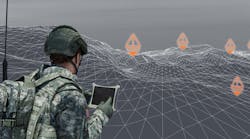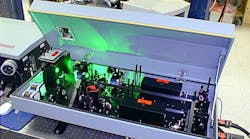10-gigabit Ethernet is enabling a new class of military systems where broadband data from a variety of sensors and other information streams can be integrated across the battlefield to improve military effectiveness.
By Jack Staub
The battlefield is continually transformed by a seemingly never-ending array of sensors and other sources of broadband information. As such, data networks are becoming an increasingly important area of technology to us as the designers of the next generation of sensors.
The capability of our military is determined by the sensors that we design-sensors that can be deployed and managed easily in the theater, while enabling their data to be shared and processed in real time to substantially improve the visibility and capability of our military forces.
“Visibility” is determined by the number and type of sensors that are deployed, as well as the information bandwidth supplied by each sensor. “Capability” is determined by the ability to distribute and analyze the information from these various broadband data streams, as well as to add new sensors and make use of them.
Improving the performance of sensor data networks results in an improved visibility and capability on the battlefield since the network can distribute richer information streams to more users by moving the network closer to the sensor front-end of systems (the “edge”) and permitting broad access to higher resolution sensors.
Many sensors will only require modest network bandwidth, while others will require substantially more. Some will do well with commodity links, while others will, by necessity, be required to push the performance envelope.
Sensor networks
10-gigabit Ethernet is the latest performance upgrade on Ethernet’s never-ending roadmap to higher levels of performance and capability. Offering 10 times the bandwidth with a fraction of the latency of its earlier 1-gigabit version, we as systems engineers now find Ethernet impossible to ignore for future systems.
As the Ethernet performance has increased, it has been applied farther onto the performance edge of the sensor network. Initially, Ethernet only was used for narrowband information like systems control and status and text communications.
Later, increased bandwidth and improved deterministic operation permitted voice, images, and low-definition video to be streamed. Today, 10-gigabit technology permits several raw data streams from the front ends of ultra-wideband sensors like radar, sonar, and signals intelligence receivers to stream directly over the same networks to other systems in the field where it can be processed, stored, and visualized by any other user or device connected to the network.
There are substantial advantages of an all-Ethernet sensor network for military systems, yet challenges in applying this technology remain-particularly in the application of Ethernet to sensors that require ultrawide bandwidth and/or ultra low-latency data communications. Here Ethernet can be applied, but it is necessary to carefully design these types of applications, as is true with any high-performance system that pushes the performance envelope.
ROI of Ethernet-based sensor networks
The long-term advantages of leveraging Ethernet as the principal network in a system or to connect several subsystems are well documented. From a system-engineering perspective, the question is now, “What justification can be made not to use Ethernet?” That is, to use some other network (or dedicated point-to-point interface) instead of Ethernet. This usually comes down to one of the following arguments:
- Ethernet is not applicable due to a special performance or security consideration; or
- Ethernet is not appropriate since the system must maintain compatibility with a legacy network, interface, or pre-installed wiring.
Insufficient performance has long been pointed out as the primary deficiency associated with using Ethernet, especially in front-end or wideband sensor applications. Those opposed argue that an Ethernet network would not be deterministic enough, or could not sustain high enough data rates, or its associated protocols were excessively taxing on its host processors, or its resulting communications latencies were too excessive to be useful.
Prior to 1-gigabit technology, all of these claims were true, but that was more than a decade ago and 1-gigabit interface and switch technologies overcame many of these limitations. Now 10-gigabit technology has developed to where none of these performance claims apply, except for perhaps in a few very extreme applications.
In some applications, incompatibility with relatively old networks or protocols can be viewed as another deficiency of Ethernet. That is, Ethernet may be dismissed from consideration because it is necessary to retain an older network or interface standard to maintain compatibility with and operate with older systems.
After all, there is an enormous investment in fielded systems and it is not practical to redesign those systems or retrofit them with Ethernet. Eventually all these systems will be redesigned or modified to tie-in with the network since the myriad of benefits will far outweigh the one-time conversion cost. Those systems that are not adapted will become less and less useful and eventually become obsolete.
Commodity and specialized flavors of Ethernet devices help engineers design systems economically. Low- and moderate-performance subsystems can leverage inexpensive commodity-grade solutions, while the more specialized and more capable Ethernet technologies (e.g. 10-gigabit interfaces with TCP/IP offload) need only be used in the few areas where more specialized capability or performance-oriented access to the network is necessary.
With regard to the design of future military systems, if there is any possibility that Ethernet can be used, it very likely will be used, and soon it may very well be required to be used. Now that 10-gigabit technology is here, the range of “possibilities” has been greatly expanded.
Jack Staub is president of Critical I/O Inc. in Irvine, Calif., a provider of high-performance interfaces for embedded, avionics, and military applications. For more information, contact Critical I/O online at www.criticalio.com or by phone at 949-553-2200.


